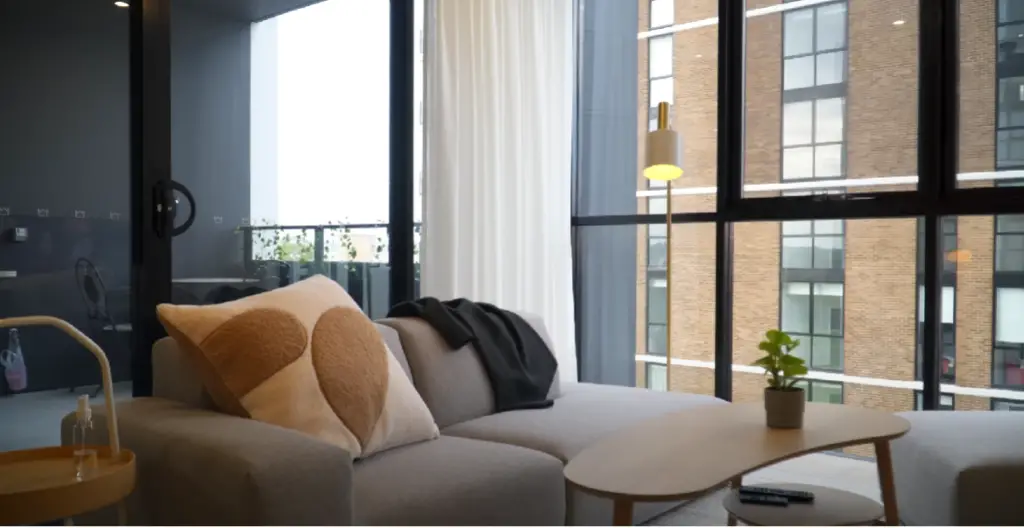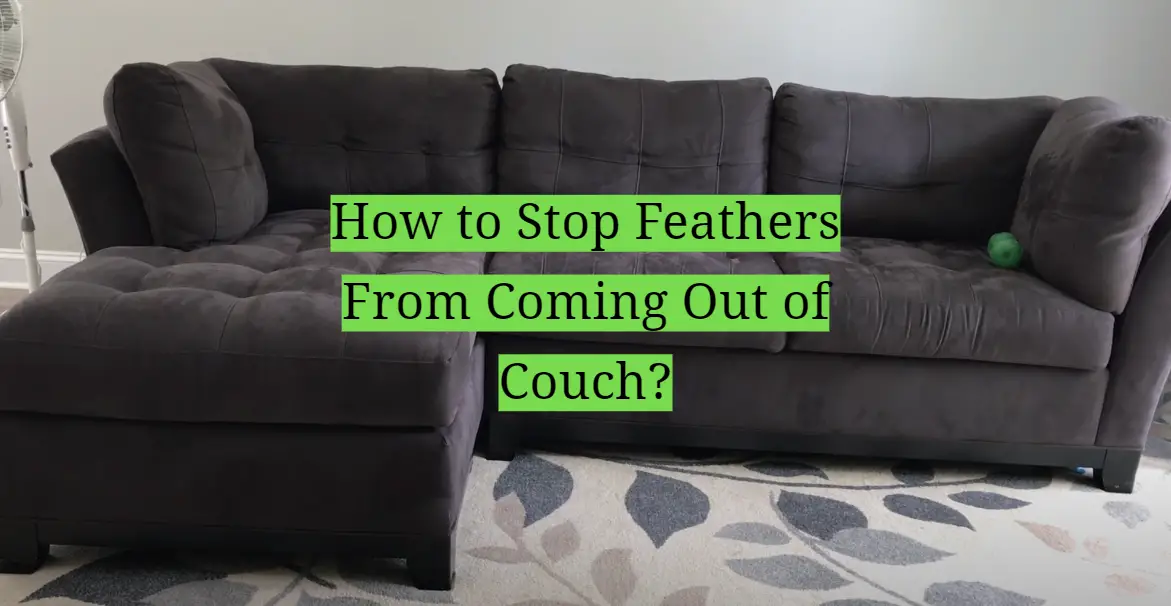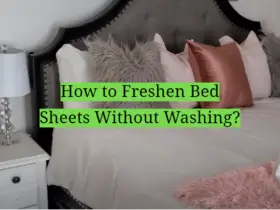Feathers escaping from your couch can become a frequent nuisance, not to mention the discomfort it can cause when you sit down to relax. While it’s commonplace for feather-stuffed couches to shed some feathers, excessive feather loss can hint at underlying issues such as fabric degradation or broken stitches. This guide provides practical steps on how to prevent feathers from coming out of your couch, helping you maintain a clean, comfortable, and feather-free living environment.
Which is superior: a foam or feather sofa?
Deciding between a foam or feather sofa ultimately boils down to personal preference as both have their unique advantages.
Foam sofas are popular for their durability, firmness, and low maintenance. High-density foam resists sagging and shape loss, offering consistent support over time. This makes foam a practical choice for those who prefer a firmer sit or have mobility concerns. However, some may find foam to be too firm and not breathable enough, which can lead to discomfort during long periods of sitting.

On the other hand, feather sofas are renowned for their supreme comfort and traditional, luxurious feel. The natural softness and pliability of feathers make these sofas perfect for those who enjoy a plush, sink-in sit. However, feather sofas require regular fluffing to maintain their shape and aren’t the best choice for people with feather allergies.
In conclusion, neither is inherently superior—it largely depends on your personal comfort preferences, maintenance willingness, budget, and lifestyle needs. Some people even opt for a blend of foam and feathers to create a sofa that combines the best of both worlds: the durability and support of foam with the luxurious comfort of feathers.
How can I determine if my couch contains feathers?
Determining whether your couch is filled with feathers can be done by checking a few things. First, look for a tag or label on your couch which should tell you what the filling material is. This tag is often located under the couch or under one of the cushions. If you can’t locate or read the tag, you can also try feeling the couch for quills or smaller feathers, as these are distinctive to the touch. Finally, it’s a clear indication that it contains some amount of feather filling.

Which types of feathers are typically utilized in sofas?
Feather-filled sofas are a luxurious, comfortable choice that many homeowners opt for. These feathers typically come in two varieties: down feathers and regular feathers. Down feathers are the soft, fluffy undercoating that provides insulation for the bird, while the feather itself is the outer coating that provides protection. In couches, the down provides the maximum comfort due to its soft and airy nature, while feathers add durability and support. However, both types of feathers can find their way out of your furniture over time. In the next section, we will discuss the common reasons for feather loss and how to prevent it from happening on your sofa. [1]

Why Does My Couch Shed Feather?
Your couch may shed feathers for several reasons.
Cheaper fabrics or those with looser weaves can allow feathers to poke through. If your couch was a budget option or is getting on in years, the fabric may have worn thin, making it easier for feathers to escape. Similarly, if the stitching in the seams has started to unravel, this could create gaps for the feathers to come out. Another reason is the cushion’s interior. If your couch uses a blend of down and feathers, the stiffer quills of the feathers can work their way out of the fabric more easily than down. Lastly, rough usage of the couch, like jumping or laying on it too harshly, can force feathers out. Understanding all the above is the first step toward resolving the issue.
Preventing Feathers from Escaping a Sofa
Preventing feathers from escaping your sofa requires a few simple, yet effective steps. Firstly, investing in a sofa cover or slipcover can provide an extra layer of protection, preventing feathers from poking through. Choose a durable material that can withstand daily usage. Secondly, regular maintenance is key. Inspect your couch regularly for any indications of deterioration or damage, especially around seams and stitching, and consider professional repairs if necessary. Lastly, gentle usage can prolong the life of your couch. Avoid jumping on the couch or placing heavy objects on it, as this can cause damage to the fabric and seams. Combining these preventative methods can help maintain the comfort and longevity of your feather-filled sofa.

What can ruin a couch?
Several factors can potentially ruin a couch, decreasing its lifespan, comfort, and aesthetic appeal:
Spills and Stains: The most common cause of couch damage is spillage of food, drinks, or other substances that can cause stubborn stains. Immediate cleaning can minimize the damage, but some materials may withstand stains better than others.
Excessive Sunlight: Constant exposure to sunlight can fade the color of your couch, particularly if it is made from natural fabrics such as cotton or silk. To prevent this, try to position your couch away from direct sunlight or use window coverings.
Pets: While we love our furry friends, they can cause considerable damage to a couch. Scratching, biting, or even pet accidents can harm the upholstery and inner materials of the couch.
Overuse: Excessive or improper use can also lead to damage. Jumping on the couch or using it as a bed can strain the structure and depreciate its durability.
Lack of Maintenance: Failing to regularly clean and maintain your couch can lead to a build-up of dust, grime, and allergens, which can degrade the material over time.

Knowing these potential hazards can help you take preventive measures to protect your couch, ensuring its longevity and ongoing comfort.[3]
What is the best filling for a couch?
The best filling for a couch largely depends on your personal preferences and needs. However, some popular options include:
Polyurethane Foam: This is a common, affordable choice that offers a range of firmness levels. High-density foam is durable and maintains its shape well, but may be considered too firm for some.
Memory Foam: Memory foam contours to the body, providing good support and comfort. However, it can retain heat and may not be the best choice for those who tend to get hot.
Feather-Down Blend: This filling provides a plush and luxurious feel, but requires regular fluffing to maintain its shape. Allergy sufferers should check the feather quality and cleaning process to avoid possible allergens.
Synthetic Fiber: Fillings like polyester fiber are hypoallergenic and offer a softer sit than foam, but may flatten out with time.
High Resilient (HR) Foam: This is a high-end choice that offers excellent durability and comfort. It’s often wrapped in polyester or down for added plushness.

Ultimately, the best couch filling for you depends on your budget, the desired level of maintenance, your comfort preferences, and any potential allergies.
FAQ
What is the best way to clean a couch filled with feathers?
Cleaning a feather-filled couch requires careful attention to not only maintain its aesthetics but also to preserve the integrity of the feathers inside. Start with a thorough vacuuming, using an upholstery attachment to gently remove dust and debris from the couch surface. Always check the care label before applying any cleaning solutions. If the label permits, you can spot clean using a mild detergent mixed with warm water. Apply this solution to a soft cloth and gently blot any stains – never rub as it can cause the stain to spread or damage the fabric. If your couch has removable cushion covers, these can often be machine washed on a gentle cycle. Always air dry these items; never put them in the dryer as it could cause shrinkage or damage. For a deep clean, consider hiring a professional upholstery cleaning service especially if your couch is a high-end investment piece.[4]
What causes the unpleasant odor from my feather couch?
An unpleasant odor from your feather couch could be caused by a few different factors. One common cause is moisture. If the couch gets wet and is not properly dried, it can lead to the growth of mold and mildew, which produce a musty smell. Another cause of odor could be the feathers themselves. Over time, natural oils from the feathers may start to smell. This is particularly true if the feathers are not properly cleaned before they are used in the couch. Accumulated dirt, dust, and pet dander can also cause unpleasant odors. Furthermore, spills of food or drinks, if not cleaned immediately, can seep into the fabric and padding, causing lingering unpleasant smells. Regular cleaning and airing can help prevent these odors. If the smell persists, professional cleaning may be required.
What is the lifespan of a feather couch?
The lifespan of a feather couch largely depends on the quality of the materials used and how well it is maintained. High-quality feather-filled couches can last anywhere from 7 to 15 years, or even longer with proper care. The fabric and construction also play a role in the lifespan. Couches made with high-end fabrics and sturdy frames can last longer, as they are more resistant to wear and tear. Regularly cleaning the couch, and addressing any signs of wear or damage promptly, can also extend the life of your feather couch. Remember, the lifespan of your couch can be significantly reduced by rough usage, neglecting maintenance, or frequent exposure to pets or children.
What causes feather loss from couches?
There are several factors that can cause your couch to shed feathers. Firstly, poor-quality fabric or stitching can cause feathers to escape more frequently. Intense wear and tear, such as heavy jumping or playing on the couch, can also lead to broken threads that allow feathers to escape. Lastly, the age of your furniture can also play a role in feather loss as the material becomes less secure over time.
What is the secret to maintaining the fluffy appearance of a feather couch?
Maintaining the fluffy appearance of a feather couch requires regular fluffing. The act of sitting compresses the feathers, causing them to clump together and lose their loft. Taking the time to fluff up the cushions daily can help maintain their plump, inviting look. To fluff a feather couch, remove the cushions and shake them vigorously. For an even fluff, punch them from different sides. This separates the feathers, helping them regain their loft. Be gentle during this process to avoid damaging the fabric or seams. Using a fabric conditioner or water mixture can help to add a soft, pleasant smell to your couch. Additionally, rotating the cushions regularly ensures that they wear evenly and maintain their shape for longer. Upright storage of cushions, when the couch is not in use, can also help to maintain loftiness. If your cushions are looking particularly flat, a professional re-stuffing may be necessary to revitalize your couch.[2]
How to prevent feathers from coming out of your couch?
Regular preventive maintenance is the most effective method to ensure that the feathers remain enclosed within your sofa. Firstly, vacuum the surface and crevices of your couch regularly using a brush attachment. This will remove any dirt and debris that might be blocking up the fabric, which reduces feather loss over time. Additionally, if your furniture is starting to show signs of wear and tear, it’s best to have the upholstery professionally repaired before further damage occurs. For extra protection, you can also purchase a cover for your couch that acts as an additional barrier against feather loss. By investing in preventative measures such as these, you can keep your sofa free of feathers for years to come.
Do couches contain real feathers?
Yes, many couches do contain real feathers. Feather-filled couches are often considered a luxurious choice due to their superior comfort and durability. The feathers used are typically duck or goose feathers, which are renowned for their softness and insulation properties. However, it’s worth noting that not all couches use real feathers. Some may use synthetic alternatives, such as polyester fiberfill or foam, particularly in more budget-friendly furniture options. Real-feather couches often come with a higher price tag due to the cost of sourcing and cleaning the feathers, and the greater level of craftsmanship required in their construction. If you’re considering a feather-filled couch, be sure to check the label or ask the retailer to confirm the filling material.
Why is my couch becoming fuzzy?
If your couch is becoming fuzzy, it’s likely due to a process known as pilling. This is a common issue with many types of upholstery fabric, particularly those made from synthetic fibers such as polyester. Pilling occurs when fibers break, split, or loose ends tangle together to form small, round lumps, or “pills.” Regular use and friction, such as sitting or rubbing against the fabric, can exacerbate pilling. Some fabrics pill more easily than others, so the extent of pilling can depend on the quality and type of fabric used for your couch. Regular gentle vacuuming, professional cleaning, or using a fabric shaver can help to remove pills and keep your couch looking its best. However, if pilling becomes excessive, it may be a sign of inferior quality fabric or require professional intervention to resolve.
In addition to taking measures to prevent pilling, it’s also important to be mindful of the use and care of your couch. Avoid harsh cleaning products, never drag the furniture or place sharp objects on it, and avoid contact with pets or spills whenever possible. Doing so can help keep your couch looking fresh and inviting for longer.
It’s also worth noting that pilling is a normal part of the wear and tear process, so don’t be too alarmed if you notice some fuzzing. Regular maintenance can help keep your couch looking its best for years to come.
As always, contact your furniture retailer or upholsterer if you have any questions or concerns about the care of your couch. They are always happy to provide advice and assistance, so don’t hesitate to reach out.
Remember that proper maintenance is the key to preserving the comfort, beauty, and longevity of your feather couch! So take the time to properly care for it, and you’ll be rewarded with a furniture investment piece that will last you for years. [5]
Are cheap feathers real?
Yes, cheap feathers are often real feathers. However, they may come from different sources or be of a different quality than the feathers used in more expensive furniture. For example, cheaper feather products may use chicken feathers, which are less soft and fluffy than duck or goose feathers, or they may use a mix of feathers and other materials, such as down or synthetic fiberfill. Moreover, the cleaning and processing standards for cheaper feathers might not be as rigorous, leading to potential issues with odor or durability. It’s always important to check the label or inquire about the source and quality of the feathers if you’re concerned about the quality and integrity of your feather-filled products.
Overall, opting for a lower-cost feather option is not necessarily a bad thing—it all depends on your needs and preferences. However, it’s always wise to do some research ahead of time to determine if the quality and construction of the product meet your standards. Ultimately, investing in higher-quality feathers will usually lead to better comfort, performance, and longevity.
With all that said, don’t forget to take proper care of your feather-filled products! Regular vacuuming and fluffing will help maintain the appearance and loftiness of the feathers while spot-cleaning any spills or stains as soon as possible is key to a longer lifespan. Taking the time to properly care for your feather furniture can make a big difference in the overall look and feel of your home.
How do you fill a couch seat?
Filling a couch seat requires some patience and diligence. Here’s how you can do it:
Remove the existing filling: Start by unzipping the cushion covers and carefully removing the existing filling. If the filling is in a casing, remove the casing as well.
Check the condition of the casing: If the casing is in good condition, you can reuse it. If it’s damaged, you’ll need to replace it with a new one.
Choose your filling: Decide on the new filling for your cushions. It could be foam, feather, down, or synthetic materials like polyester fiberfill. Keep in mind that different fillings offer different levels of comfort and durability.
Fill the casing: Begin stuffing the casing with your chosen filling. Ensure the filling is evenly distributed to avoid lumps.
Reshape the filling: Once the casing is filled, reshape it by pressing down and smoothing out the surface. This ensures the filling fits the shape of the cushion cover.
Replace the casing in the cover: Carefully insert the filled casing back into the cushion cover. Make sure the corners of the casing align with the corners of the cover.
Close the cover: Finally, zip up the cushion cover, ensuring that no filling is caught in the zipper.
Remember to measure your cushions and purchase the correct amount of filling. Overstuffing can strain the seams of the cover, while understaffing will result in a flat and uncomfortable cushion. Regular fluffing and rotation can help maintain the shape and comfort of your couch seat.[6]
How can I make my sofa more attractive?
Enhancing the attractiveness of your sofa can be achieved through a few simple strategies:
Use Throw Pillows: Throw pillows can instantly add color, texture, and personality to your sofa. Opt for pillows in various shapes, sizes, and patterns for a more eclectic and visually interesting look.
Add a Throw Blanket: Drape a throw blanket over the back or arm of the sofa. It adds an additional layer of texture and color and also increases the comfort factor.
Update the Upholstery: If your sofa fabric is worn out or you’re ready for a change, consider reupholstering your sofa. Choose a fabric that complements the rest of your decor while also being durable and easy to clean.
Accessorize with a Slipcover: Slipcovers are a quick and cost-effective way to completely change the look of your sofa. They are available in a variety of materials, colors, and patterns.
Position Strategically: The way you position your sofa in the room can also affect its appeal. Try positioning it facing a focal point, such as a fireplace or a window with a view.
Maintain Regularly: Regular cleaning and maintenance can help your sofa retain its attractiveness. Vacuum it regularly, attend to spills immediately, and fluff the cushions to keep it looking its best.
Remember, the most attractive sofa is one that reflects your style and complements the overall aesthetic of your room.[4]
Useful Video: How to Maintain Down Sofa Cushions
Conclusion
In conclusion, feather-filled couches are a luxurious and comfortable choice for furniture. While they require a higher level of maintenance and care, the effort is worthwhile for the superior comfort and longevity they offer. Regular fluffing, rotating, and spot-cleaning can help maintain the quality of your feather couch for years to come. It’s also important to be mindful of the quality of feathers used in your furniture. Cheaper feathers may not offer the same comfort and durability as more premium options. However, with the right care and attention, even a couch filled with less expensive feathers can provide a comfortable and inviting place to relax. Always feel free to reach out to your furniture retailer or upholsterer with any concerns or needs for advice. Take the time to care for your feather-filled furniture, and it will undoubtedly be a long-lasting investment for your home.
References:
- https://homedecorbliss.com/how-to-stop-feathers-from-coming-out-of-couch/
- https://www.ehow.com/how_7663565_care-featherstuffed-sofa.html
- https://www.darlingsofchelsea.co.uk/blog/the-ultimate-guide-to-sofa-stuffing
- https://www.nepacarpetcleaning.com/my-upholstered-furniture-has-fuzzy-balls-known-as-pilling-can-this-be-cleaned/
- https://foundfeathers.org/2019/08/29/craft-store-feathers/
- https://www.plumbs.co.uk/articles/inspiration/how-long-should-a-sofa-last/














Leave a Reply